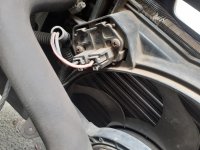Hello all. I'm having a bit of an episode with the cooling on my mk2 1.2 16v. It started with my heating going away and the car couldn't switch from petrol to lpg. I thought it was air inside the system, tried bleeding it out and while doing that, revving the engine, it started to spew out the coolant. I've had to bleed the system many times before and it's never done that. Maybe if I've filled it to the top it would rise when it's heated up but the fan would kick in and it'd just spit a bit of coolant. This time it threw a lot of it out and fan never started spinning. I flushed the heater core, heating and lpg came back, but while bleeding the spewing of coolant continued. The fan would kick in at 98 degrees, however I think it should be at 95. By the time it does start spinning coolant starts boiling and spewing out if I don't put the cap on the expansion tank. I thought maybe the system is clogged somewhere else, put in some radiator flush in the system (which I didn't really want to do), did multiple flushes with water, but in the end, no effect. Changed the temperature sensor and the rheostat on the big radiator. No effect.
Finally gave up, bled the system and called it a day.
What's bothering me is this: first, the temp gauge goes to the middle after too long time driving and sometimes plays around a bit. It's warm outside now so it should go dead center and stay there in a matter of minutes. Second, the other day there's been a build up of pressure, cause there was a big coolant leak from the expansion cap after I'd parked the car. I'm sure the coolant level wasn't high and I've been driving it for two weeks since last flush. Fan didn't kick in again if it was too much heat. I usually wait for the fan to stop when I hear it and then turn the engine off. Hasn't happened again since. I check the pressure every time I get home.
So, yeah. Bit of a read, but it's been going on for some time and I can't explain it to myself anymore. I went to a place I trust a while back when I thought the fan was the problem, the guy said the car is fine and couldn't find a fault. Reading a lot of other forums some people suggest that this is all a symptom of a head gasket on it's way out the door.
Any thoughts would be appreciated.
Finally gave up, bled the system and called it a day.
What's bothering me is this: first, the temp gauge goes to the middle after too long time driving and sometimes plays around a bit. It's warm outside now so it should go dead center and stay there in a matter of minutes. Second, the other day there's been a build up of pressure, cause there was a big coolant leak from the expansion cap after I'd parked the car. I'm sure the coolant level wasn't high and I've been driving it for two weeks since last flush. Fan didn't kick in again if it was too much heat. I usually wait for the fan to stop when I hear it and then turn the engine off. Hasn't happened again since. I check the pressure every time I get home.
So, yeah. Bit of a read, but it's been going on for some time and I can't explain it to myself anymore. I went to a place I trust a while back when I thought the fan was the problem, the guy said the car is fine and couldn't find a fault. Reading a lot of other forums some people suggest that this is all a symptom of a head gasket on it's way out the door.
Any thoughts would be appreciated.



